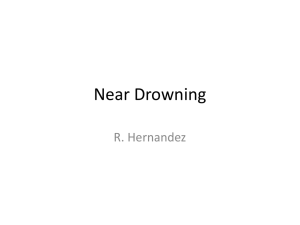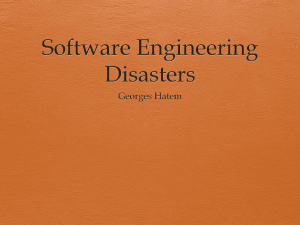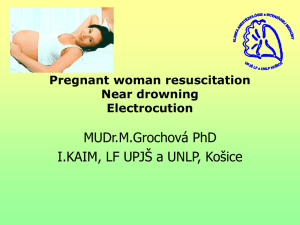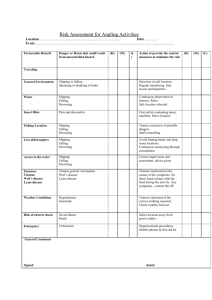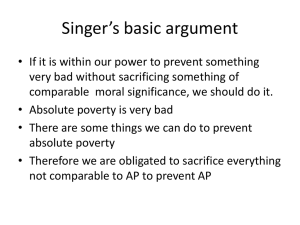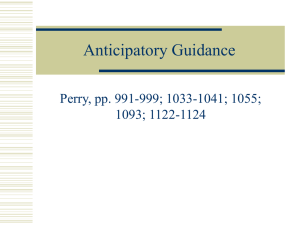Chapter 4: Drowning - Queensland Family and Child Commission
advertisement
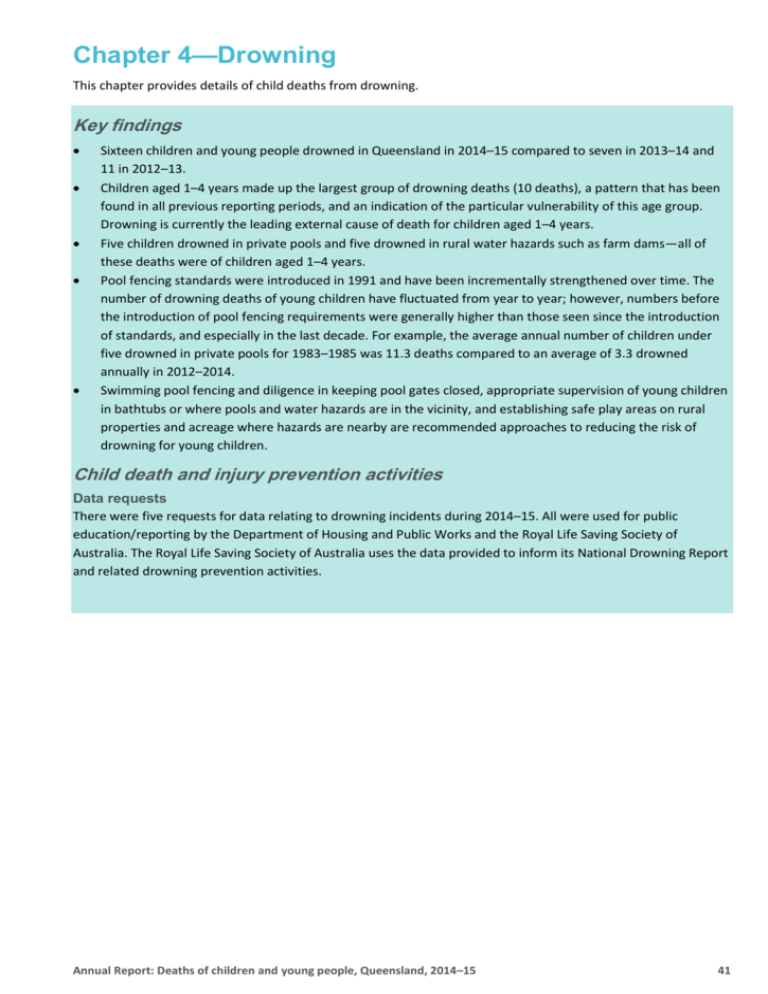
Chapter 4—Drowning This chapter provides details of child deaths from drowning. Key findings Sixteen children and young people drowned in Queensland in 2014–15 compared to seven in 2013–14 and 11 in 2012–13. Children aged 1–4 years made up the largest group of drowning deaths (10 deaths), a pattern that has been found in all previous reporting periods, and an indication of the particular vulnerability of this age group. Drowning is currently the leading external cause of death for children aged 1–4 years. Five children drowned in private pools and five drowned in rural water hazards such as farm dams—all of these deaths were of children aged 1–4 years. Pool fencing standards were introduced in 1991 and have been incrementally strengthened over time. The number of drowning deaths of young children have fluctuated from year to year; however, numbers before the introduction of pool fencing requirements were generally higher than those seen since the introduction of standards, and especially in the last decade. For example, the average annual number of children under five drowned in private pools for 1983–1985 was 11.3 deaths compared to an average of 3.3 drowned annually in 2012–2014. Swimming pool fencing and diligence in keeping pool gates closed, appropriate supervision of young children in bathtubs or where pools and water hazards are in the vicinity, and establishing safe play areas on rural properties and acreage where hazards are nearby are recommended approaches to reducing the risk of drowning for young children. Child death and injury prevention activities Data requests There were five requests for data relating to drowning incidents during 2014–15. All were used for public education/reporting by the Department of Housing and Public Works and the Royal Life Saving Society of Australia. The Royal Life Saving Society of Australia uses the data provided to inform its National Drowning Report and related drowning prevention activities. Annual Report: Deaths of children and young people, Queensland, 2014–15 41 Drowning, 2012–2015 A copy of Table 4.1 containing data since 2004 is available online at www.qfcc.qld.gov.au Table 4.1: Summary of drowning deaths of children and young people in Queensland, 2012–2015 2012–13 2013–14 2014–15 Total Rate per Total Rate per Total Rate per n 100,000 n 100,000 n 100,000 All drowning deaths Drowning 11 1.0 7 0.6 16 1.4 Pool drowning deaths Pool drowning deaths 8 0.7 2 * 5 0.5 Private pools 8 0.7 2 * 5 0.5 Public pools 0 0.0 0 0.0 0 0.0 Non-pool drowning deaths Non-pool drowning deaths 3 * 5 0.5 11 1.0 Static inland 0 0.0 2 * 2 * waterways Rural water hazards 2 * 1 * 5 0.5 Dynamic inland 0 0.0 2 * 1 * waterways Bathtubs 0 0.0 0 0.0 1 * Beach/ocean 1 * 0 0.0 1 * Other 0 0.0 0 0.0 1 * Sex Female 3 * 2 * 5 0.9 Male 8 1.4 5 0.9 11 1.9 Age category Under 1 year 0 0.0 0 0.0 1 * 1–4 years 8 3.2 3 * 10 4.0 5–9 years 1 * 2 * 5 1.6 10–14 years 0 0.0 0 0.0 0 0.0 15–17 years 2 * 2 * 0 0.0 Aboriginal and Torres Strait Islander status Indigenous 1 * 1 * 1 * Non-Indigenous 10 1.0 6 0.6 15 1.5 Geographical area of usual residence (ARIA+) Remote 0 0.0 0 0.0 2 * Regional 7 1.7 3 * 8 2.0 Metropolitan 4 0.6 4 0.6 5 0.8 Socio-economic status of usual residence (SEIFA) Low to very low 5 1.1 5 1.1 8 1.8 Moderate 3 * 1 * 4 1.9 High to very high 3 * 1 * 3 * Known to the child protection system Known to the child protection 5 3.0 4 2.4 2 * system Yearly average Rate per 100,000 1.0 0.5 0.5 0.0 0.6 * * * * * * * 1.4 * 2.8 * 0.0 * * 1.0 * 1.5 0.7 1.4 * * Data source: Queensland Child Death Register (2012–2015) * Rates have not been calculated for numbers less than four. . . Average across the three-year period has not been calculated due to the break in series (see note 3). 1. Data presented here is current in the Queensland Child Death Register as at June 2015 and thus may differ from those presented in previously published reports. 2. Rates are based on the most up-to-date denominator data available and are calculated per 100,000 children (in the age/sex/Indigenous status/ARIA region/SEIFA region) in each year. 3. For 2013–14 and all earlier periods, the number of children known to the child protection system represents the number of children, whose deaths were registered in the reporting period, who were known to the Department of Communities in the three-year period prior to their death. For 2014–15, this was changed to the deaths of children known to the Department of Communities in the one-year period prior to their death. 4. ARIA+ and SEIFA were not able to be calculated for children whose usual place of residence was not Queensland. 5. Average annual rates have been calculated using the estimated resident population data at June 2013 (the mid-point for the period). 6. The non-pool drowning category of ‘other’ includes flood-related drownings. 42 Queensland Family & Child Commission .. Drowning: Findings, 2014–15 Between 1 July 2014 and 30 June 2015, 16 children and young people drowned in Queensland, representing a rate of 1.4 deaths per 100,000 children aged 0–17 years.28 The highest annual number of drowning deaths over the last 11 years was 19 and occurred in 2008–09 and 2009–10, while the lowest number of drowning deaths was seven in 2013–14.29 Types of drowning-related deaths Eleven deaths occurred in non-pool water hazards (comprising rural water hazards, static and dynamic inland waterways, bathtubs, beaches and floodwaters). Five pool drownings were recorded for the period with all of the incidents occurring in private pools. The deaths occurred in water hazards both at, and away from, the child’s usual place of residence. Resuscitation was attempted in 13 of the drownings by an adult supervisor or by attending ambulance officers. Resuscitation may not have been attempted if there was a considerably protracted period of time before the child was located. Information available to QFCC indicated that four of the five pool locations did not have signs displayed nearby with details of cardiopulmonary resuscitation procedures (CPR). From 30 November 2015, it will be mandatory for all residential pools to have a CPR sign attached to the safety barrier of the pool; or displayed near the pool, so that the sign is easily visible to a person near the pool. One pool-related drowning and one beach/ocean drowning occurred at locations outside of Queensland. Sex Eleven of the 16 children and young people who drowned in 2014–15 were male. Males continue to be overrepresented in childhood drowning data, both within Queensland and throughout Australia.30 Age Children aged 1–4 years made up the largest group of drowning deaths (10 deaths)—a pattern that has been found in all previous reporting periods, and an indication of the particular vulnerability of this age group. Aboriginal and Torres Strait Islander status One of the 16 children and young people who drowned identified as Aboriginal and Torres Strait Islander. Geographical area of usual residence (ARIA+) Eight of the 16 children and young people who drowned usually resided in regional areas, five were from metropolitan areas and two were from remote areas.31 Socio-economic status of usual residence (SEIFA) There were eight drowning deaths of children and young people who usually resided in low to very low socioeconomic areas. Four deaths were reported for moderate, and three for high to very high socio-economic areas. 31 Children known to the child protection system Two of the 16 children and young people who drowned were known to the child protection system. 28 Findings presented here are based on the number of children who drowned whose deaths were registered with the Registry of Births, Deaths and Marriages in 2014–15. These figures may differ from the number of child drownings that occurred during the period. The analysis of deaths by date-of-death registration is in accordance with national datasets managed by the Australian Bureau of Statistics and the Australian Institute of Health and Welfare, as well as child death datasets managed by other Australian states and territories. 29 Tables with data for 2004 to 2015 are available online at www.qfcc.qld.gov.au 30 Royal Life Saving Society—Australia. National Drowning Report 2014. 31 Note that ARIA+ and SEIFA breakdowns exclude one child whose usual residence was outside of Queensland. Annual Report: Deaths of children and young people, Queensland, 2014–15 43 Key issues Swimming pool fencing Children under the age of five are most at risk of drowning. Compliant swimming pool fencing is a key contributor in reducing the risk of drowning for this age group but should not be over-relied upon, as other factors are also important. These include active supervision and water safety education. The effectiveness of swimming pool fencing is dependent upon fencing and gates being compliant with the regulation, in good working order and used correctly (such as not propping open a pool gate). Table 4.2 (later in this chapter) indicates that an open or defective pool gate was noted for three of the five pool drowning deaths of young children in 2014–15. Figure 4.1 tracks the number of drowning deaths of young children in private pools over time against changes to fencing requirements. A number changes in pool fencing standards have occurred—from no standards in place prior to 1991, to requirements for fencing for new pools later extended to existing pools, changes in requirements such as fence height, and more recently compliance requirements for registration and inspections. The average annual number of drowning deaths fluctuated over the first decade (to 1993), before gradually declining over the last two decades (1996–2014). Three-year annual averages prior to 1991 ranged between 9.7 and 14.7, whereas most recently the averages were at 5.0 for 2007–2009 dropping to 3.3 for 2012–2014. Data presented in Figure 4.1 is based on date of death, as opposed to date of registration. The figures presented below will therefore be different from those published in the rest of the report. 15 15 15 14 12 12 Number of deaths 3 year rolling average 12 11 10 10 9 8 7 7 6 7 6 6 6 5 5 3 2 3 2 1991–1998 standards 1998–2003 standards 2003–2006 standards 2010 2009 2008 2007 2006 2005 2004 2003 2002 2001 2000 1999 1998 1997 1996 1995 1994 1993 1992 1991 1990 1989 1988 1987 1986 1985 1 Pre-1991 (no pool standards) 3 2006–2012 standards 2 2014 4 2013 7 2012 7 2011 7 1984 16 15 14 13 12 11 10 9 8 7 6 5 4 3 2 1 0 1983 Number of deaths Figure 4.1: Drowning deaths of children 0–4 years in private pools by applicable pool standard, 1983–2014 2012– current standard Year Data sources: Queensland Injury Surveillance Unit 2008, Injury Bulletin: Domestic pool immersion in Queensland children under five years of age. No.104; Queensland Child Death Register (2004–2014) 1. The above data represents the number of deaths that occurred in each calendar year. These figures will therefore not align with the summary of drowning deaths presented in Table 4.1 of this report, which are based on date of death registration by financial year. Supervision Lapses in supervision of young children in or near water hazards has been found to be a factor in drowning deaths of young children. A drowning supervision model32 has been applied to examine the supervision that occurred in drowning deaths for Queensland children aged under five years. This allows for common breakdowns in supervision to be identified to assist in informing drowning prevention strategies. 32 Developed by the former CCYPCG. 44 Queensland Family & Child Commission The model examines drowning deaths in categories based on whether the child was known—or not known—to be in, on or around water. This is because the threshold of supervision required for children known to be in, on or around water is higher due to the presence of a significant hazard, than that of children not known to be in, on or around water. The key elements of supervision examined are the: capacity of the supervisor proximity of the supervisor to the child continuity of supervision. When a child is not known to be in, on or around water, it is still important to provide a level of supervision to ensure that the child is protected from all hazards. Young children are unable to appropriately identify and negotiate risks, yet can be highly mobile. Reliance only on pool fences and gates to prevent drowning is not recommended, as breakdowns in protections can occur, such as pool gates being propped open or becoming noncompliant due to wear and tear. Accordingly, it is essential that children under five years are regularly checked on by an active supervisor and that there are other protections to reduce the risk of drowning (or access to other hazards) should there be a lapse in supervision. In 2014–15, there were seven drowning deaths of children aged under five, who were known to be in, on, or around water. A child is known to be in, on or around water when the child is known by carers to be actively swimming, paddling, wading, playing, bathing in water or on a watercraft, or the carers are aware of the existence of a nearby water hazard, and a reasonable person could foresee that the child could quickly or easily gain access to it (i.e. no barrier or a defective barrier). An example includes where a carer leaves the child playing in the backyard but has propped open the pool gate. A combination of factors, including ineffective barriers to water hazards, proximity of the supervisor and continuity of supervision were identified as being relevant to these deaths (see Table 4.2). It is important to acknowledge that not all drowning deaths are reasonably foreseeable or the result of a breakdown in the elements of supervision occurring for the child. Sometimes a child is not known to be in, on or around water and is being appropriately supervised by a capable supervisor, but a resourceful and inquisitive child may manage to bypass protections, unbeknown to the supervisor. These child deaths highlight the importance of having many and varied protections in place for the child, inclusive of adequate supervision. The role of safe play areas in reducing rural drownings Rural water hazards, such as dams and troughs, may not be considered risks due to the distance from the family home; however, children can travel significant distances (for their age) to access water hazards—some as far as one kilometre. Any water hazard should therefore be considered a potential risk regardless of its location on the property. Five drownings were associated with rural water hazards during the 2014–15 period, predominantly in dams. All of the deaths involved children aged 1–4 years. Most of the water hazards were located within 100 metres of the residence, highlighting the need for consideration of safe play areas to reduce the number of childhood drownings in rural settings. There have been 27 deaths in rural water hazards since 2004. Removing water hazards near the house may not always be practical. Drowning prevention is most effective when strategies are multi-faceted. Active supervision is the most effective strategy to prevent drowning; but to maintain this continuously is not realistic. Therefore, other strategies should be in place for when lapses in supervision occur. Establishing a safe play area around the family home can act as a critical means of preventing access to water hazards. Children can also be taught from a young age about nearby dangers and ‘no go’ areas. Annual Report: Deaths of children and young people, Queensland, 2014–15 45 Risk factors Table 4.2 (over page) outlines the types of risk factors and the frequency of risk factors present for every drowning fatality in 2014–15. As illustrated, the length of time young children were left unsupervised can vary. Drowning can occur in the minutes when parents and carers are not actively supervising their child, or when they become distracted. Of the children aged under 10 years, 12 were known to have been non-swimmers. Water safety awareness programs can improve children’s swimming ability and water safety; however, young children may be too developmentally immature to respond effectively when immersed in water, and swimming lessons should not be relied on as a means of drowning prevention. A range of safety strategies is essential, such as ensuring pool gates are compliant and active supervision by an appropriate adult. 46 Queensland Family & Child Commission Annual Report: Deaths of children and young people, Queensland, 2014–15 47 1 7 other beach static inland waterway dynamic inland waterway static inland waterway pool (private) dam pool (private) pool (private) dam pool (private) pool (private) dam dam livestock dip bath Type of water hazard < 5 mins n/a 7 < 5 mins n/a n/a n/a < 5 mins < 5 mins < 5 mins 5-9 mins 5-9 mins undetermined undetermined 10-14 mins undetermined 5-9 mins 15-29 mins 10-14 mins inadequate inadequate inadequate inadequate adequate undetermined inadequate inadequate undetermined n/a < 5 mins < 5 mins Length of time child left unsupervised adequate inadequate 6 1 Inadequate supervision 5 0 undetermined not stated 5 0 3 0 not stated 3 0 Inadequate/ Defective or defective/ no fencing open gate or safety barrier Known risk factors 5 0 5 0 Rural drowning hazard not stated not stated non-swimmer competent non-swimmer non-swimmer non-swimmer non-swimmer non-swimmer non-swimmer not stated non-swimmer non-swimmer non-swimmer non-swimmer non-swimmer Swimming ability 2 1 1 0 Known to the child protection system Data source: Queensland Child Death Register (2014–15) = Risk factor identified for the child based on the evidence available at the time of reporting. 1. Regional or remote and low SES refers to location of incident as opposed to area of usual residence. 2. Supervision is based on the CCYPCG model for classifying caregiver supervision in infant and toddler drowning deaths (children aged 0–4 years). Inadequate supervision is considered based on whether the child was known to be in, on, or around water, the capacity of the supervisor to respond, the proximity of the supervisor to the child, and the continuity of supervision. 3. Children and young people aged five and over are not included in the supervision model, therefore ‘n/a’ has been used in the ‘Inadequate Supervision’ column for these children and young people. 4. Inadequate / defective / no fencing or safety barrier includes swimming pool regulation safety barriers and non-regulated safe play areas on rural properties. Total male 10 n/a n/a male female male female 3 3 5–9 years 1 n/a n/a male female male male female female male male male male 3 6 1–4 years 0 male Low SES 1 0 Under 1 year Regional/ remote 1 Indigenous Sex Table 4.2: Summary of characteristics of all children and young people who drowned in 2014–15 Demographics Queensland Ambulance Service data The Queensland Ambulance Service (QAS) has provided data on the number of ambulance responses to immersion incidents involving children in 2014–15, where children may have drowned or experienced near drowning. Table 4.3 shows the total number of QAS responses, and includes both fatal and nonfatal injuries. Across the reporting periods, immersion incidents were most common in the 1–4 year age category. Table 4.3: QAS immersion incidents (fatal and non-fatal), 2010–2015 2010–11 2011–12 2012–13 Age category n n n Under 1 year 28 15 28 2013–14 n 2014–15 n 27 35 1–4 years 91 72 130 94 133 5–9 years 12 20 41 30 35 10–14 years 13 14 27 33 43 15–17 years Total 29 173 21 142 16 242 25 209 26 272 Data source: Queensland Ambulance Service (2010–15) 1. Excludes data for two children and young people in 2014–15 whose age at the time of the incident was not known. 48 Queensland Family & Child Commission
